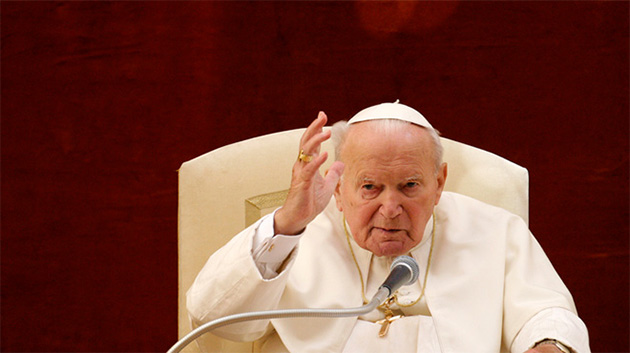The Pope Who Defeated Communism
A Role Model For Chinese Democratization
Photo : giulio napolitano / Shutterstock.com
Key points in this article:
- Pope John Paul II’s ideal of freedom and Poland’s democratization revolution
- The impact of the John Paul II’s 1979 visit to Poland
- John Paul II established the church in people’s minds
The Beijing government released Liu Xia, the wife of Nobel Prize laureate Liu Xiaobo, on the occasion of the one year anniversary of her husband’s death. The Global Times, run by People’s Daily, the official Communist Party newspaper, has demanded that Western media stop making Liu Xia out to be a human rights hero.
After Liu Xiaobo died of liver cancer on July 13, 2017, his remains were cremated and the ashes were scattered in the ocean before the public had a chance to openly mourn his passing. All of this was allegedly undertaken ‘by the family’s request’. That’s why those paying their respects are seen praying towards the ocean.
Why is the Beijing government with its massive army and police force so obsessed about erasing the memories of one dead man with no authoritative power? This is because they know from history that revolutions can begin with just an ideology, which eventually can grow into a power stronger than any military force.
While there were many causes that brought the end of the Cold War and the dissolution of the Soviet Union, one of the decisive causes of the fall of the Iron Curtain was the chain of democratization revolutions that sprang up in Eastern Europe, which began in Poland in 1989. Arguably the man behind this movement was Pope John Paul II, the 264th Pope of the Catholic Church.
John Paul II’s Ideology and the Revolutions
The flame of revolution was first lit in Poland on the Pope’s visit in 1979.
John Paul II himself was born in Poland in 1920 with the name Jozef Wojtyla. The Nazis, however, later invaded his homeland. Religious persecution was severe under Nazi rule: half of Poland’s priests were taken to concentration camps, and 1 in 5 was killed. The infamous camp, Auschwitz, was built in Poland, and thus the country was stained by the blood of Jews almost more than Germany itself.
Having survived the Nazi invasion, Wojtyla ascertained that only Christian faith could free the people of Poland. In 1942 he accepted ordainment as his vocation, and entered the Bishop’s Palace in Krakow to study.
During WWII, the Yalta Conference ceded Poland to the Soviet Union, and thus Poland became a communist country. Religious oppression continued under Soviet rule, and their crosses were stripped off the churches, and monasteries were bombed and destroyed, just as is the case in China now. The officials tried to uproot faith from the people’s hearts.
Having experienced life under two totalitarian regimes, Wojtyla developed his own thoughts on the ‘freedom of conscience’ and the ‘freedom of faith’.
Finally, in 1978, Wojtyla was elected Pope. He was the first non-Italian pope in 455 years, and the man from behind the Iron Curtain immediately became famous.
In 1976 before becoming Pope, Wojtyla said
“Man’s hunger is nothing but the hunger for true freedom”
“It is a basic trait of mankind and it is the source of human dignity”
God created all people, so no person must be treated like a robot, he believed.
He also believed that faith was the highest form of human expression. Faith teaches us who we are, and without the freedom of faith, people will never know who they truly are.
The Impact of John Paul II’s Visit to Poland
1. The Poles Realized That God was on Their Side
John Paul II visited his homeland, Poland, in July 1979. Millions of people gathered to hear his sermon at the public Mass, and a total of 12 million people (one third of the population of Poland) came to see the Pope over 9 days.
67,000 police officers and 20,000 secret police kept watch over the triumphant visit, but their pressure strategy was meaningless. They were overwhelmed by the united power of the congregation.
Pope John Paul II offered a sermon:
Let your Spirit descend.
Let your Spirit descend
And renew the face of the earth,
The face of this land
Amen.
And the people responded by chanting, “We want God” over and over. Their voice echoed throughout the city.
British historian Timothy Garton Ash says in his book “The Polish Revolution” that suddenly the people realized that Poland was not a communist country, but a country dominated by communist powers.
In other words, the Poles suddenly realized that they were not communists, but the victims of communist rule. The Polish trade union, Solidarity, which became the central force for the revolution recalls:
“That day, we became stronger and felt assured that we were protected by God.”
John Paul II’s visit to Poland encouraged in the people a feeling that God was on their side.
2. Faith Brought Together the Intellectuals and the Laborers
The Polish rebellions of the 1970’s all ended in failure when the authorities succeeded in splitting the rebel powers into intellectuals and laborers. John Paul II’s visit was a moment when the two factions became one again.
In August 1980, a worker’s strike at Gdansk Shipyard developed into the formation of a Catholic-based trade union called Solidarity. John Paul II’s strong belief that “humans were created to be free” united the two factions and helped establish the fully independent self-managing union.
Historians tend to think of Solidarity as an ordinary workers movement. But every day the strikers at the Gdansk Shipyard would pray to a portrait of the Pope. They would sing chorales and resistance songs together. During the 16 months when Solidarity was active, over 10 million people joined the strike. We want God in every aspect of our lives!” they would shout.
Before John Paul II was elected Pope, he had spent 10 years leading a church building project in the town of Nowa Huta. After becoming Pope, he built spiritual churches in the minds of people in Poland and other countries all over Eastern Europe.
This was the Revolution of Eastern Europe that led to the dissolution of the Soviet Union.
Without a Polish Pope, the Revolutions of 1989 would not have come about. Without him we would not have seen the dramatic changes that Gorbachev made to the Eastern Europe policy, and without these changes there would have been no Velvet Revolution (the democratization revolution in Czechoslovakia).
The interconnected waves of revolution also manifested in Charta 77, the democratization movement in Czechoslovakia from 1976 to 1992; and this became the basis for Liu Xiaobo’s Charter 08, his manifesto for protection of private property and the freedom of faith, speech, publication and association.
Ideologies – not military force – lead to revolution. That hope is still alive now in China.
(Hanako Cho)



















